ECO mode KIA OPTIMA 2020 Features and Functions Guide
[x] Cancel search | Manufacturer: KIA, Model Year: 2020, Model line: OPTIMA, Model: KIA OPTIMA 2020Pages: 591, PDF Size: 14.1 MB
Page 237 of 591
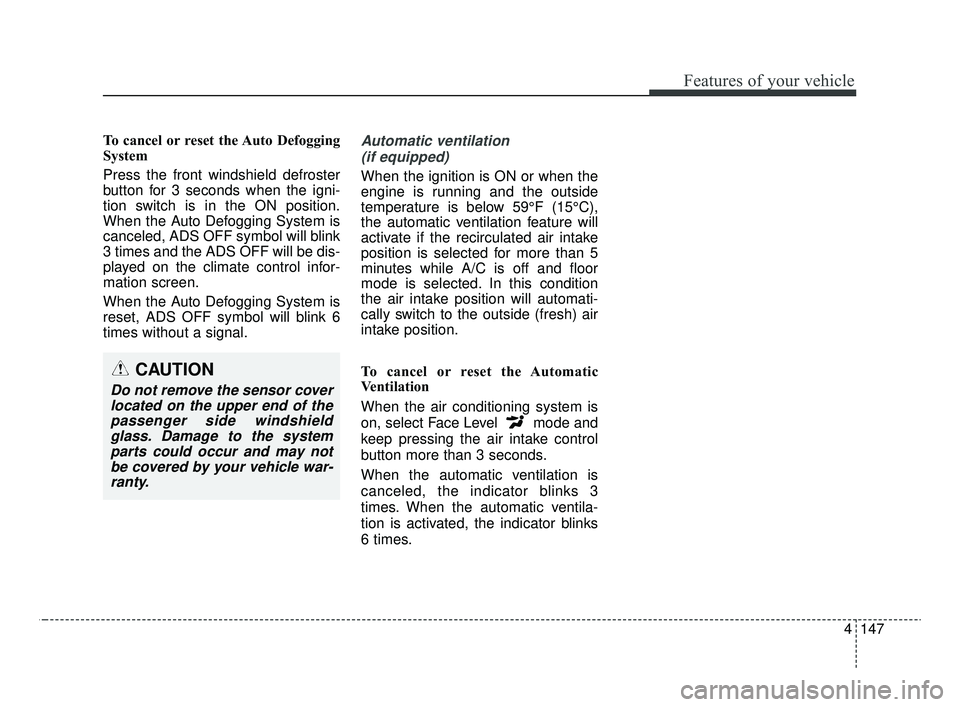
4147
Features of your vehicle
To cancel or reset the Auto Defogging
System
Press the front windshield defroster
button for 3 seconds when the igni-
tion switch is in the ON position.
When the Auto Defogging System is
canceled, ADS OFF symbol will blink
3 times and the ADS OFF will be dis-
played on the climate control infor-
mation screen.
When the Auto Defogging System is
reset, ADS OFF symbol will blink 6
times without a signal.Automatic ventilation(if equipped)
When the ignition is ON or when the
engine is running and the outside
temperature is below 59°F (15°C),
the automatic ventilation feature will
activate if the recirculated air intake
position is selected for more than 5
minutes while A/C is off and floor
mode is selected. In this condition
the air intake position will automati-
cally switch to the outside (fresh) air
intake position.
To cancel or reset the Automatic
Ventilation
When the air conditioning system is
on, select Face Level mode and
keep pressing the air intake control
button more than 3 seconds.
When the automatic ventilation is
canceled, the indicator blinks 3
times. When the automatic ventila-
tion is activated, the indicator blinks
6 times.
CAUTION
Do not remove the sensor coverlocated on the upper end of thepassenger side windshieldglass. Damage to the systemparts could occur and may notbe covered by your vehicle war-ranty.
JFa PE USA 4.qxp 5/15/2019 3:24 PM Page 147
Page 258 of 591
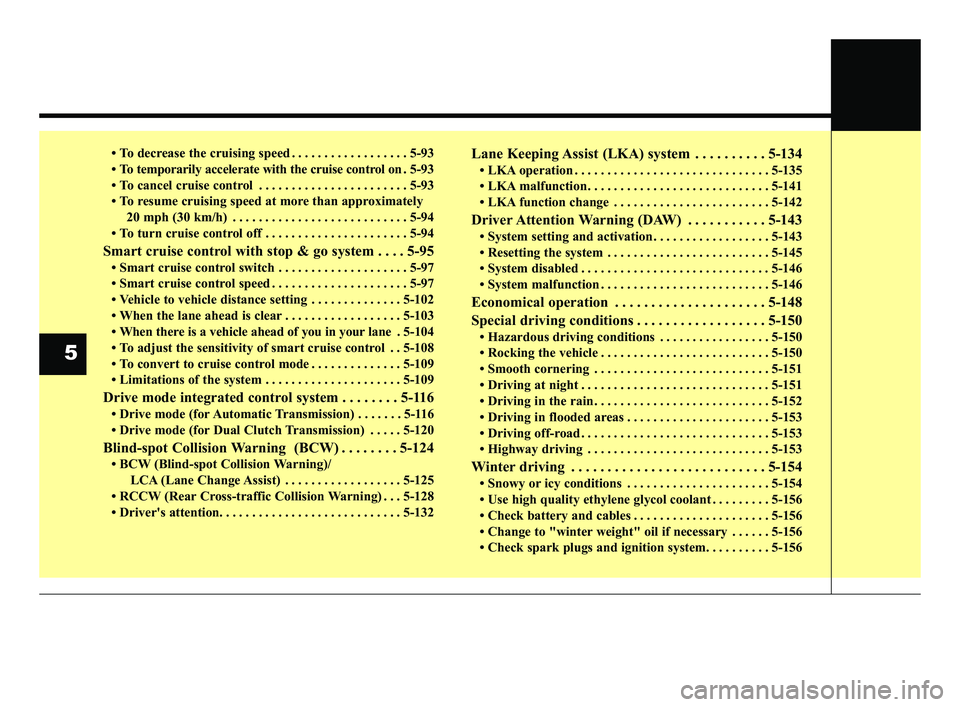
• To decrease the cruising speed . . . . . . . . . . . . . . . . . . 5-93
• To temporarily accelerate with the cruise control on . 5-93
• To cancel cruise control . . . . . . . . . . . . . . . . . . . . . . . 5-93
• To resume cruising speed at more than approximately 20 mph (30 km/h) . . . . . . . . . . . . . . . . . . . . . . . . . . . 5-94
• To turn cruise control off . . . . . . . . . . . . . . . . . . . . . . 5-94
Smart cruise control with stop & go system . . . . 5-95
• Smart cruise control switch . . . . . . . . . . . . . . . . . . . . 5-97
• Smart cruise control speed . . . . . . . . . . . . . . . . . . . . . 5-97
• Vehicle to vehicle distance setting . . . . . . . . . . . . . . 5-102
• When the lane ahead is clear . . . . . . . . . . . . . . . . . . 5-103
• When there is a vehicle ahead of you in yourlane . 5-104
• To adjust the sensitivity of smart cruise control . . 5-108
• To convert to cruise control mode . . . . . . . . . . . . . . 5-109
• Limitations of the system . . . . . . . . . . . . . . . . . . . . . 5-109
Drive mode integrated control system . . . . . . . . 5-116
• Drive mode (for Automatic Transmission) . . . . . . . 5-116
• Drive mode (for Dual Clutch Transmission) . . . . . 5-120
Blind-spot Collision Warning (BCW) . . . . . . . . 5-124
• BCW (Blind-spot Collision Warning)/ LCA (Lane Change Assist) . . . . . . . . . . . . . . . . . . 5-125
• RCCW (Rear Cross-traffic Collision Warning) . . . 5-128
• Driver's attention. . . . . . . . . . . . . . . . . . . . . . . . . . . . 5-132
Lane Keeping Assist (LKA) system . . . . . . . . . . 5-134
• LKA operation . . . . . . . . . . . . . . . . . . . . . . . . . . . . . . 5-135
• LKA malfunction . . . . . . . . . . . . . . . . . . . . . . . . . . . . 5-141
• LKA function change . . . . . . . . . . . . . . . . . . . . . . . . 5-142
Driver Attention Warning (DAW) . . . . . . . . . . . 5-143
• System setting and activation . . . . . . . . . . . . . . . . . . 5-143
• Resetting the system . . . . . . . . . . . . . . . . . . . . . . . . . 5-145
• System disabled . . . . . . . . . . . . . . . . . . . . . . . . . . . . . 5-146
• System malfunction . . . . . . . . . . . . . . . . . . . . . . . . . . 5-146
Economical operation . . . . . . . . . . . . . . . . . . . . . 5-148
Special driving conditions . . . . . . . . . . . . . . . . . . 5-150
• Hazardous driving conditions . . . . . . . . . . . . . . . . . 5-150
• Rocking the vehicle . . . . . . . . . . . . . . . . . . . . . . . . . . 5-150
• Smooth cornering . . . . . . . . . . . . . . . . . . . . . . . . . . . 5-151
• Driving at night . . . . . . . . . . . . . . . . . . . . . . . . . . . . . 5-151
• Driving in the rain . . . . . . . . . . . . . . . . . . . . . . . . . . . 5-152
• Driving in flooded areas . . . . . . . . . . . . . . . . . . . . . . 5-153
• Driving off-road . . . . . . . . . . . . . . . . . . . . . . . . . . . . . 5-153
• Highway driving . . . . . . . . . . . . . . . . . . . . . . . . . . . . 5-153
Winter driving . . . . . . . . . . . . . . . . . . . . . . . . . . . 5-154
• Snowy or icy conditions . . . . . . . . . . . . . . . . . . . . . . 5-154
• Use high quality ethylene glycol coolant . . . . . . . . . 5-156
• Check battery and cables . . . . . . . . . . . . . . . . . . . . . 5-156
• Change to "winter weight" oil if necessary . . . . . . 5-156
• Check spark plugs and ignition system. . . . . . . . . . 5-156
5
JFa PE USA 5.QXP 5/15/2019 3:20 PM Page 2
Page 265 of 591

59
Driving your vehicle
Starting the engine
1.Make sure the parking brake isapplied.
2.Place the transmission shift lever in P (Park). Depress the brake pedal
fully.
You can also start the engine when
the shift lever is in the N (Neutral)
position. 3.Turn the ignition switch to START
and hold it there until the engine
starts (a maximum of 10 seconds),
then release the key.
It should be started withoutdepressing the accelerator.
4.Do not wait for the engine to warm up while the vehicle remains sta-
tionary.
Start driving at moderate engine
speeds. (Steep accelerating and
decelerating should be avoided.) If the engine stalls while you are in
motion, do not attempt to move the
shift lever to the P (Park) position. If
traffic and road conditions permit,
you may put the shift lever in the N
(Neutral) position while the vehicle is
still moving and turn the ignition
switch to the START position in an
attempt to restart the engine.
CAUTION- Starter
Do not engage the starter for
more than 10 seconds. If theengine stalls or fails to start,wait 5 to 10 seconds before re-engaging the starter. Improperuse of the starter may damageit.
WARNING- Steering
wheel
Never reach for any controls
through the steering wheel
while the vehicle is in motion.
The presence of your hand or
arm in this area could cause a
loss of vehicle control.
WARNING- Proper footwear
Always wear appropriate shoes
when operating your vehicle.
Unsuitable shoes (high heels,
ski boots, sandals, etc.) may
interfere with your ability to use
the brake and accelerator pedal.
JFa PE USA 5.QXP 5/15/2019 3:21 PM Page 9
Page 268 of 591

Driving your vehicle
12
5
Starting the engine with a
smart key
1.Carry the smart key or place it
inside the vehicle.
2.Make sure the parking brake is firmly applied
3.Place the transmission shift lever in P (Park). Depress the brake pedal
fully.
You can also start the engine whenthe shift lever is in the N (Neutral)position.
4.Press the engine start/stop button while depressing the brake pedal.
It should be started withoutdepressing the accelerator.
5.Do not wait for the engine to warm up while the vehicle remains sta-
tionary.
Start driving at moderate engine
speeds. (Steep accelerating and
decelerating should be avoided.)
Even if the smart key is in the vehi- cle, if it is far away from you, the
engine may not start. When the engine start/stop button
is in the ACC position or above, if
any door is opened, the system
checks for the smart key. If the
smart key is not in the vehicle, a
message "key is not in the vehicle"
will appear on the LCD display. And
if all doors are closed, the chime
will sound for 5 seconds. The indi-
cator or warning will turn off while
the vehicle is moving. Always have
the smart key with you.
If the battery is weak or the smartkey does not work correctly, you
can start the engine by pressing
the engine start/stop button with
the smart key.
The side with the lock button
should contact the engine
start/stop button directly.
When you press the engine
start/stop button directly with the
smart key, the smart key should
contact the button at a right angle.
WARNING - Unintended
vehicle movement
Never leave the smart key in the
vehicle with children or vehicle
occupants who are unfamiliar
with the vehicle operation.
Pushing the engine start/stop
button while the smart key is in
the vehicle may result in unin-
tended engine activation and/or
unintended vehicle movement.
OJFHP058009
JFa PE USA 5.QXP 5/15/2019 3:21 PM Page 12
Page 275 of 591
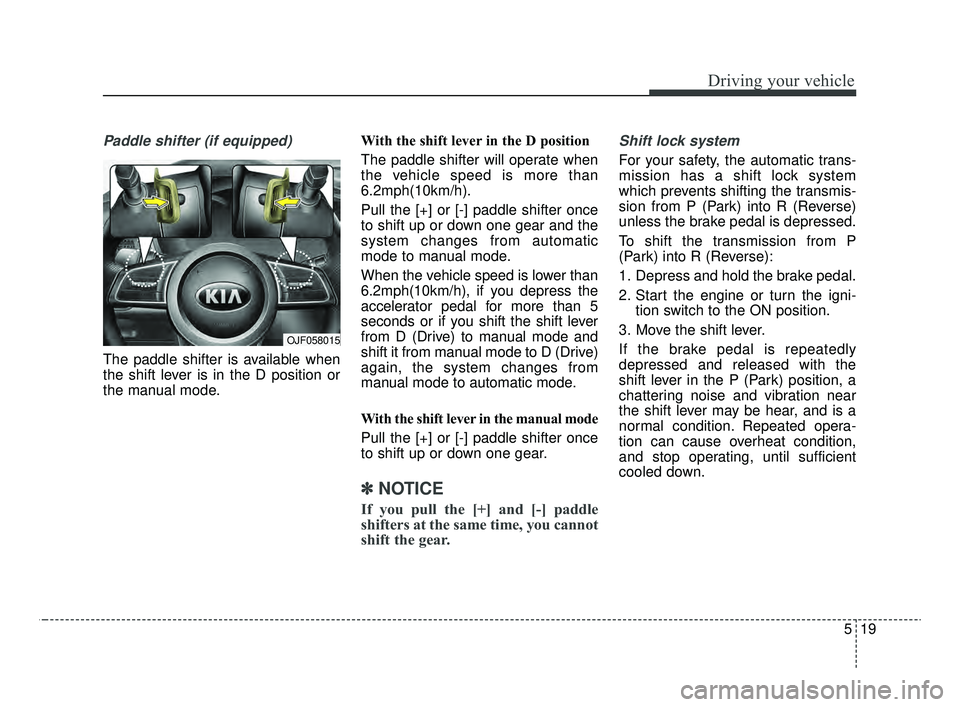
519
Driving your vehicle
Paddle shifter (if equipped)
The paddle shifter is available when
the shift lever is in the D position or
the manual mode.With the shift lever in the D position
The paddle shifter will operate when
the vehicle speed is more than
6.2mph(10km/h).
Pull the [+] or [-] paddle shifter once
to shift up or down one gear and the
system changes from automatic
mode to manual mode.
When the vehicle speed is lower than
6.2mph(10km/h), if you depress the
accelerator pedal for more than 5
seconds or if you shift the shift lever
from D (Drive) to manual mode and
shift it from manual mode to D (Drive)
again, the system changes from
manual mode to automatic mode.
With the shift lever in the manual mode
Pull the [+] or [-] paddle shifter once
to shift up or down one gear.
✽ ✽
NOTICE
If you pull the [+] and [-] paddle
shifters at the same time, you cannot
shift the gear.
Shift lock system
For your safety, the automatic trans-
mission has a shift lock system
which prevents shifting the transmis-
sion from P (Park) into R (Reverse)
unless the brake pedal is depressed.
To shift the transmission from P
(Park) into R (Reverse):
1. Depress and hold the brake pedal.
2. Start the engine or turn the igni-
tion switch to the ON position.
3. Move the shift lever.
If the brake pedal is repeatedly
depressed and released with the
shift lever in the P (Park) position, a
chattering noise and vibration near
the shift lever may be hear, and is a
normal condition. Repeated opera-
tion can cause overheat condition,
and stop operating, until sufficient
cooled down.
OJF058015
JFa PE USA 5.QXP 5/17/2019 4:30 PM Page 19
Page 284 of 591
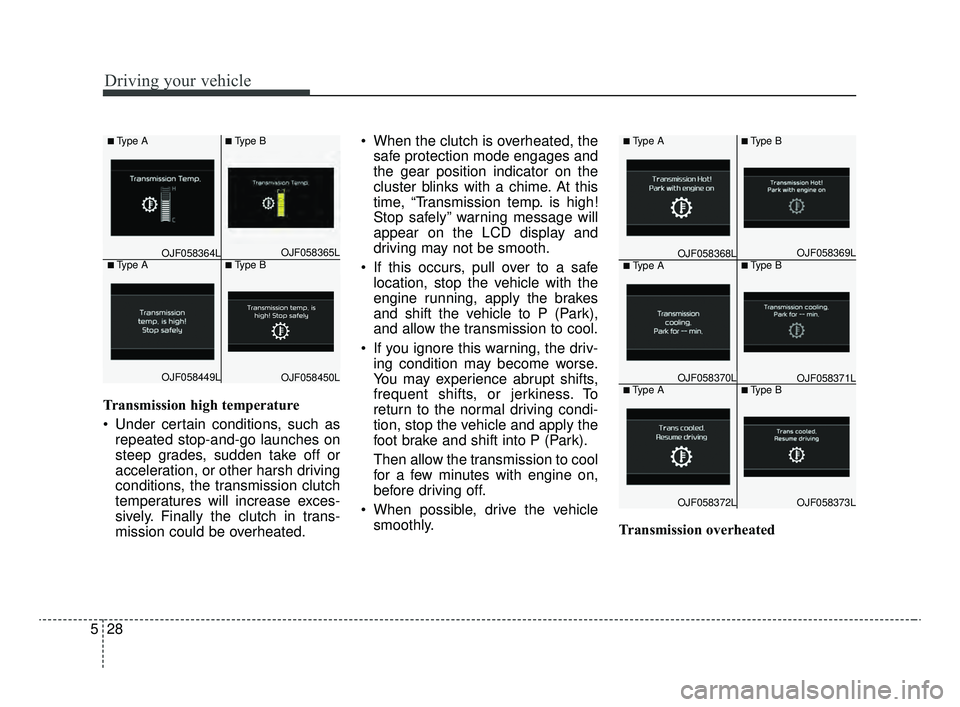
Driving your vehicle
28
5
Transmission high temperature
Under certain conditions, such as
repeated stop-and-go launches on
steep grades, sudden take off or
acceleration, or other harsh driving
conditions, the transmission clutch
temperatures will increase exces-
sively. Finally the clutch in trans-
mission could be overheated. When the clutch is overheated, the
safe protection mode engages and
the gear position indicator on the
cluster blinks with a chime. At this
time, “Transmission temp. is high!
Stop safely” warning message will
appear on the LCD display and
driving may not be smooth.
If this occurs, pull over to a safe location, stop the vehicle with the
engine running, apply the brakes
and shift the vehicle to P (Park),
and allow the transmission to cool.
If you ignore this warning, the driv- ing condition may become worse.
You may experience abrupt shifts,
frequent shifts, or jerkiness. To
return to the normal driving condi-
tion, stop the vehicle and apply the
foot brake and shift into P (Park).
Then allow the transmission to cool
for a few minutes with engine on,
before driving off.
When possible, drive the vehicle smoothly. Transmission overheated
■Type A■Type B
OJF058369L■Type A■Type B
■Type A■Type B
OJF058372LOJF058373L
OJF058368L
OJF058370LOJF058371L
■Type A■Type B
OJF058365L■Type A■Type B
OJF058449LOJF058450L
OJF058364L
JFa PE USA 5.QXP 5/15/2019 3:22 PM Page 28
Page 364 of 591
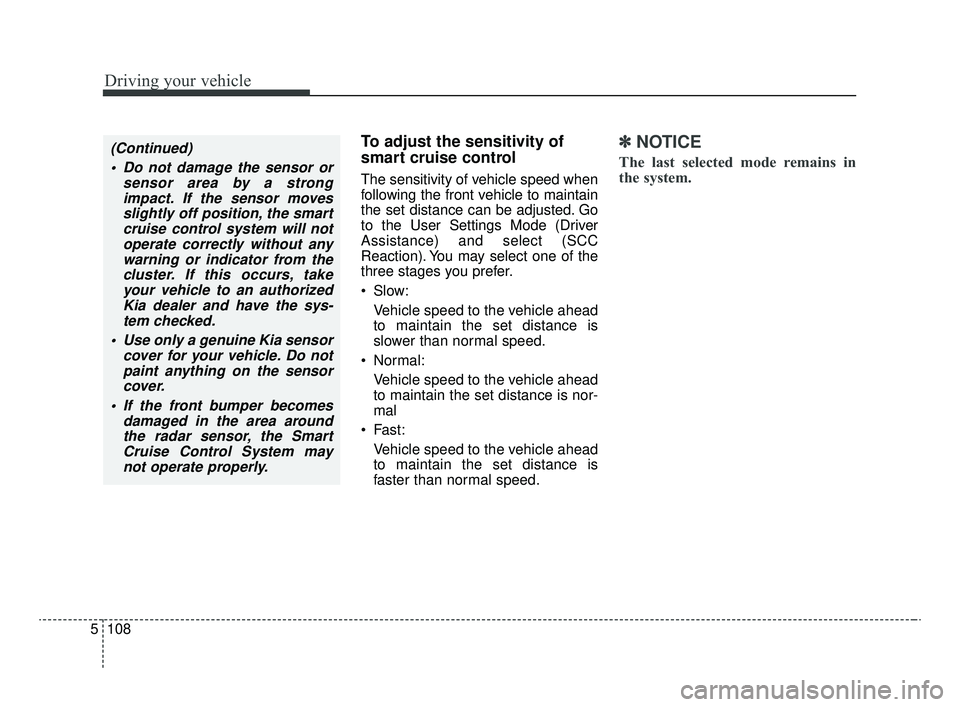
Driving your vehicle
108
5
To adjust the sensitivity of
smart cruise control
The sensitivity of vehicle speed when
following the front vehicle to maintain
the set distance can be adjusted. Go
to the User Settings Mode (Driver
Assistance) and select (SCC
Reaction). You may select one of the
three stages you prefer.
Slow:
Vehicle speed to the vehicle ahead
to maintain the set distance is
slower than normal speed.
Normal: Vehicle speed to the vehicle ahead
to maintain the set distance is nor-
mal
Fast: Vehicle speed to the vehicle ahead
to maintain the set distance is
faster than normal speed.
✽ ✽ NOTICE
The last selected mode remains in
the system.(Continued)
Do not damage the sensor or sensor area by a strongimpact. If the sensor movesslightly off position, the smartcruise control system will notoperate correctly without anywarning or indicator from thecluster. If this occurs, takeyour vehicle to an authorizedKia dealer and have the sys-tem checked.
Use only a genuine Kia sensor cover for your vehicle. Do notpaint anything on the sensorcover.
If the front bumper becomes damaged in the area aroundthe radar sensor, the SmartCruise Control System maynot operate properly.
JFa PE USA 5.QXP 5/15/2019 3:26 PM Page 108
Page 365 of 591
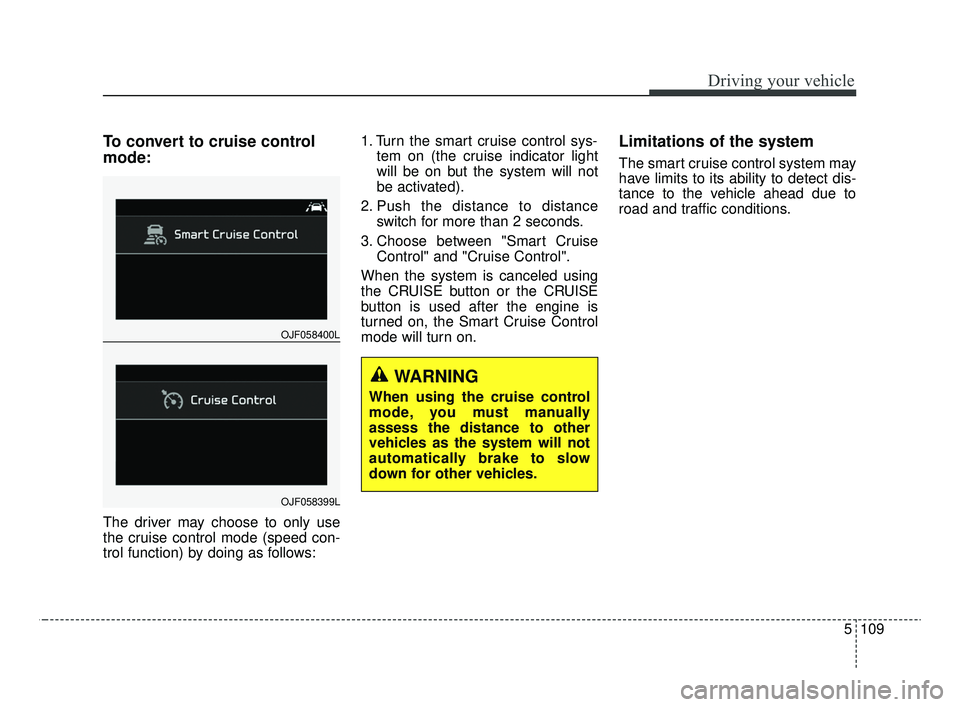
5109
Driving your vehicle
To convert to cruise control
mode:
The driver may choose to only use
the cruise control mode (speed con-
trol function) by doing as follows:1. Turn the smart cruise control sys-
tem on (the cruise indicator light
will be on but the system will not
be activated).
2. Push the distance to distance switch for more than 2 seconds.
3. Choose between "Smart Cruise Control" and "Cruise Control".
When the system is canceled using
the CRUISE button or the CRUISE
button is used after the engine is
turned on, the Smart Cruise Control
mode will turn on.
Limitations of the system
The smart cruise control system may
have limits to its ability to detect dis-
tance to the vehicle ahead due to
road and traffic conditions.
WARNING
When using the cruise control
mode, you must manually
assess the distance to other
vehicles as the system will not
automatically brake to slow
down for other vehicles.
OJF058400L
OJF058399L
JFa PE USA 5.QXP 5/15/2019 3:26 PM Page 109
Page 372 of 591

Driving your vehicle
116
5
Drive mode (for Automatic
Transmission)
SMART mode (if equipped) :
SMART mode automatically
adjusts the driving mode (COM-
FORT ↔ECO ↔SPORT) in
accordance with the driver's driv-
ing habits.
COMFORT mode : COMFORT mode provides smooth driving and
comfortable riding. When COM-
FORT mode is selected, it is not
displayed on the cluster.
SPORT mode : SPORT mode pro- vides sporty but firm riding.
ECO mode : ECO mode improves fuel efficiency for eco-friendly driv-
ing.
DRIVE MODE INTEGRATED CONTROL SYSTEM
OJFA055054
■Type A
■Type B
OJFA055055
OJFA055053
■Type C
The drive mode may be selected
according to the driver’s preference
or road condition.
The mode changes whenever the
DRIVE MODE button is pressed.
JFa PE USA 5.QXP 5/15/2019 3:27 PM Page 116
Page 373 of 591

5117
Driving your vehicle
SMART mode (if equipped)
SMART mode selects the
proper driving mode
among ECO, COMFORT
and SPORT by judging the
driver's driving habits (i.e.
Economical or Aggressive)
from the brake pedal
depression or the steering
wheel operation.
Press the DRIVE MODE button to activate SMART mode. When
SMART mode is activated, the
indicator illuminates on the instru-
ment cluster.
The indicator illuminates in blue, when the driver's driving is catego-
rized to be mild. It illuminates in
white, when the driver's driving is
categorized to be normal. It illumi-
nates in red, when the driver's driv-
ing is categorized to be dynamic
during abrupt braking or sharp
curving. The vehicle starts in SMART
mode, when the engine was turned
OFF in SMART mode.
SMART mode automatically con- trols the vehicle driving, such as
gear shifting patterns, engine
torque, riding quality in accordance
with the driver's driving habits.
✽ ✽ NOTICE
• When you mildly drive the vehicle
in SMART mode, the driving
mode changes to ECO mode to
improve fuel efficiency. However,
the actual fuel efficiency may dif-
fer in accordance with your driv-
ing situations (i.e. upward/down-
ward slope, vehicle
deceleration/acceleration).
• When you dynamically drive the vehicle in SMART mode by
abruptly decelerating or sharply
curving, the driving mode changes
to SPORT mode. However, it may
adversely affect fuel economy.SMART
JFa PE USA 5.QXP 5/15/2019 3:27 PM Page 117